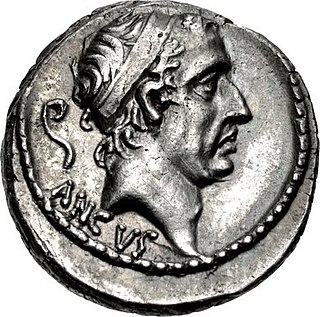
Ancus Marcius was the legendary fourth king of Rome, who traditionally reigned 24 years. Upon the death of the previous king, Tullus Hostilius, the Roman Senate appointed an interrex, who in turn called a session of the assembly of the people who elected the new king. Ancus is said to have ruled by waging war as Romulus did, while also promoting peace and religion as Numa did.
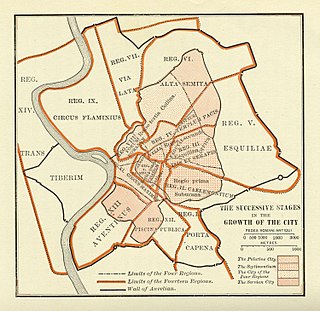
The Roman Kingdom was the earliest period of Roman history when the city and its territory were ruled by kings. According to oral accounts, the Roman Kingdom began with the city's founding c. 753 BC, with settlements around the Palatine Hill along the river Tiber in central Italy, and ended with the overthrow of the kings and the establishment of the Republic c. 509 BC.
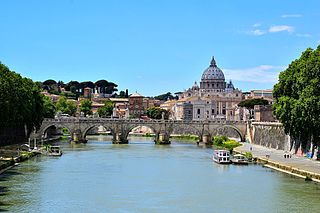
The Tiber is the third-longest river in Italy and the longest in Central Italy, rising in the Apennine Mountains in Emilia-Romagna and flowing 406 km (252 mi) through Tuscany, Umbria, and Lazio, where it is joined by the River Aniene, to the Tyrrhenian Sea, between Ostia and Fiumicino. It drains a basin estimated at 17,375 km2 (6,709 sq mi). The river has achieved lasting fame as the main watercourse of the city of Rome, which was founded on its eastern banks.

Publius Horatius Cocles was an officer in the army of the early Roman Republic who famously defended the Pons Sublicius from the invading army of Etruscan King Lars Porsena of Clusium in the late 6th century BC, during the war between Rome and Clusium. By defending the narrow end of the bridge, he and his companions were able to hold off the attacking army long enough to allow other Romans to destroy the bridge behind him, blocking the Etruscans' advance and saving the city.

The ancient Romans were the first civilization to build large, permanent bridges. Early Roman bridges used techniques introduced by Etruscan immigrants, but the Romans improved those skills, developing and enhancing methods such as arches and keystones. There were three major types of Roman bridge: wooden, pontoon, and stone. Early Roman bridges were wooden, but by the 2nd century stone was being used. Stone bridges used the arch as their basic structure, and most used concrete, the first use of this material in bridge-building.

Lars Porsena was an Etruscan king known for his war against the city of Rome. He ruled over the city of Clusium. There are no established dates for his rule, but Roman sources often place the war at around 508 BC.

The Janiculum, occasionally the Janiculan Hill, is a hill in western Rome, Italy. Although it is the second-tallest hill in the contemporary city of Rome, the Janiculum does not figure among the proverbial Seven Hills of Rome, being west of the Tiber and outside the boundaries of the ancient city.
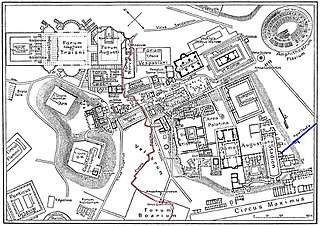
The Cloaca Maxima was one of the world's earliest sewage systems. Its name derives from Cloacina, a Roman goddess. Built during either the Roman Kingdom or early Roman Republic, it was constructed in Ancient Rome in order to drain local marshes and remove waste from the city. It carried effluent to the River Tiber, which ran beside the city. The sewer started at the Forum Augustum and ended at the Ponte Rotto and Ponte Palatino. It began as an open air canal, but it developed into a much larger sewer over the course of time. Agrippa renovated and reconstructed much of the sewer. This would not be the only development in the sewers. By the first century CE all eleven Roman aqueducts were connected to the sewer. After the Roman Empire fell the sewer still was used. By the 1800s it became a tourist attraction. Some parts of the sewer are still used today. Whilst still being used it was highly valued as a sacred symbol of Roman culture, and Roman engineering.

Trastevere is the 13th rione of Rome: it is identified by the initials R. XIII and it is located within Municipio I. Its name comes from Latin trans Tiberim, literally 'beyond the Tiber'.

The Via Ostiensis was an important road in ancient Rome. It ran west 30 kilometres (19 mi) from the city of Rome to its important sea port of Ostia Antica, from which it took its name. The road began near the Forum Boarium, ran between the Aventine Hill and the Tiber River along its left (eastern) bank, and left the city's Servian Walls through the Porta Trigemina. When the later Aurelian Walls were built, the road left the city through the Porta Ostiensis. In the late Roman Empire, trade suffered under an economic crisis, and Ostia declined as an important port. With the accompanying growth of importance of the Via Portuensis from the time of Constantine onwards, that of the Via Ostiensis correspondingly decreased. Modern Via Ostiense, following a similar path, is the main connection of Rome to Ostia together with the Via del Mare. On its way to Ostia, the road passes by the important basilica of Saint Paul Outside the Walls.

The Pons Aemilius, today called Ponte Rotto, is the oldest Roman stone bridge in Rome, Italy. Preceded by a wooden version, it was rebuilt in stone in the 2nd century BC. It once spanned the Tiber, connecting the Forum Boarium with Trastevere; a single arch in mid-river is all that remains today, lending the bridge its name Ponte Rotto.

Ponte Sublicio, also known as Ponte Aventino or Ponte Marmoreo, is a bridge linking Piazza dell'Emporio to Piazza di Porta Portese in Rome (Italy), in the Rioni Ripa, Trastevere and Testaccio and in the Quartiere Portuense.
The Roman–Etruscan Wars were a series of wars fought between ancient Rome and the Etruscans. Information about many of the wars is limited, particularly those in the early parts of Rome's history, and in large part is known from ancient texts alone. The conquest of Etruria was completed in 265–264 BC.
Spurius Larcius was one of the leading men of the early Roman Republic, of which he was twice consul. However, his greatest fame was won as one of the defenders of the Sublician bridge against the army of Lars Porsena, the King of Clusium.

Titus Herminius, surnamed Aquilinus, was one of the heroes of the Roman Republic. He participated in two of the most famous conflicts that attended the birth of the Republic, and was elected consul in 506 BC. However, his greatest fame was won as one of the defenders of the Sublician bridge against the army of Lars Porsena, the King of Clusium.

Horatius Coclès is an opera in one act and nine scenes by the French composer Étienne Nicolas Méhul with a libretto by Antoine-Vincent Arnault. It was first performed at the Paris Opéra on 18 February 1794. It is based on the Roman legend of Horatius Cocles.

The Emporium was the river port of the ancient Rome, that rose approximately between the Aventine Hill and the Rione Testaccio.

Ponte Palatino, also known as Ponte Inglese, is a bridge that links Lungotevere Aventino to Lungotevere Ripa in Rome (Italy), in the Rioni Ripa and Trastevere.
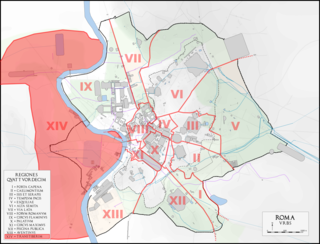
The Regio XIV Transtiberim is the fourteenth regio of imperial Rome, under Augustus's administrative reform. Meaning "across the Tiber", the Regio took its name from its position on the west bank of the Tiber River.





















